Effect of Embedded Depth of Copper-Nickel-Plated Sensor Probes on Compressive Strength Development of Mortar
Abstract
1. Introduction
2. Literature Review
3. Problem Statement and Research Objective
4. Research Methodology
5. Experiment Materials and Methods
5.1. Materials and Mix Design
5.2. Sensor and Specimen Size Setting
5.3. Production of Test Specimens
6. Finite Element Analysis
7. Results and Discussion
8. Conclusions
- The compressive test and FE analysis results demonstrate an increasing trend in compressive strength when the embedment depth increases. The presence of the probe indeed influenced the mortar strength, as the specimen without the probe exhibited the strongest compressive strength. This finding emphasizes the significance of the embedment location of the sensor probe in the development of the compressive strength of mortar. Based on these observations, it is recommended the probe be embedded at a minimum depth of 30 mm from the surface of the mortar structure;
- Both the experiment and numerical analyses showed that the average compressive strength of the 10 mm specimen was more than twice that of the 5 mm specimen. The relatively rapid failure of the 5 mm specimen was attributed to the concentrated load on the probe caused by embedding the sensor probe too close to the surface of the mortar specimen;
- The difference between the elastic modulus of the mortar was 28 times that of the sensor probe. Consequently, both the compressive strength test and finite element analysis results confirm that cracks occurred around the probe at the interface of the two materials;
- A proposed predictive equation was determined based on the test results. This predictive equation can be applied to estimate the compressive strength of mortar when a sensor probe with a nickel-plated copper surface has been buried in mortar comprising ordinary Portland cement if the embedded distance is obtained.
Author Contributions
Funding
Institutional Review Board Statement
Informed Consent Statement
Data Availability Statement
Acknowledgments
Conflicts of Interest
References
- Rose, K.; Eldridge, S.; Chapin, L. The internet of things: An overview. Internet Soc. (ISOC) 2015, 80, 1–50. [Google Scholar]
- Singh, M.K.; Amin, S.I.; Imam, S.A.; Sachan, V.K.; Choudhary, A. A Survey of Wireless Sensor Network and its types. In Proceedings of the 2018 International Conference on Advances in Computing, Communication Control and Networking (ICACCCN), Greater Noida, India, 12–13 October 2018; pp. 326–330. [Google Scholar] [CrossRef]
- Abdelmadjid, M.K.; Noureddine, S.; Amina, B.; Khelifa, B.; Tariq, B.; Boubakeur, L. IoT and WSNs Technology for Control in the Greenhouse Agriculture-Review. In Proceedings of the 2022 3rd International Conference on Embedded & Distributed Systems (EDiS), Oran, Algeria, 2–3 November 2022; pp. 136–141. [Google Scholar] [CrossRef]
- Sehrawat, D.; Gill, N.S. Smart sensors: Analysis of different types of IoT sensors. In Proceedings of the 2019 3rd International Conference on Trends in Electronics and Informatics (ICOEI), Tirunelveli, India, 23–25 April 2019; pp. 523–528. [Google Scholar] [CrossRef]
- Ojha, T.; Misra, S.; Raghuwanshi, N.S. Wireless sensor networks for agriculture: The state-of-the-art in practice and future challenges. Comput. Electron. Agric. 2015, 118, 66–84. [Google Scholar] [CrossRef]
- Ko, J.; Lu, C.; Srivastava, M.B.; Stankovic, J.A.; Terzis, A.; Welsh, M. Wireless sensor networks for healthcare. Proc. IEEE 2010, 98, 1947–1960. [Google Scholar] [CrossRef]
- Song, S.; Hou, Y.; Guo, M.; Wang, L.; Tong, X.; Wu, J. An investigation on the aggregate-shape embedded piezoelectric sensor for civil infrastructure health monitoring. Constr. Build. Mater. 2017, 131, 57–65. [Google Scholar] [CrossRef]
- Frei, M.; Deb, C.; Stadler, R.; Nagy, Z.; Schlueter, A. Wireless sensor network for estimating building performance. Autom. Constr. 2020, 111, 103043. [Google Scholar] [CrossRef]
- Taheri, S. A review on five key sensors for monitoring of concrete structures. Constr. Build. Mater. 2019, 204, 492–509. [Google Scholar] [CrossRef]
- Wang, W.; Zhao, K.; Zhang, P.; Bao, J.; Xue, S. Application of three self-developed ECT sensors for monitoring the moisture content in sand and mortar. Constr. Build. Mater. 2021, 267, 121008. [Google Scholar] [CrossRef]
- Tang, S.W.; Yao, Y.; Andrade, C.; Li, Z. Recent durability studies on concrete structure. Cem. Concr. Res. 2015, 78, 143–154. [Google Scholar] [CrossRef]
- Jedidi, M.; Benjeddou, O. Chemical causes of concrete degradation. MOJ Civ. Eng 2018, 4, 40–46. [Google Scholar] [CrossRef]
- Shang, H.-S.; Yi, T.-H. Freeze-thaw durability of air-entrained concrete. Sci. World J. 2013, 2013, 650791. [Google Scholar] [CrossRef]
- Lorenzi, A.; Stein, K.; Reginatto, L.A.; Pinto da Silva Filho, L.C. Concrete structures monitoring using ultrasonic tests. Rev. Constr. 2020, 19, 246–257. [Google Scholar] [CrossRef]
- Wu, C.; Xiang, H.; Jiang, S.; Ma, S. Stress Monitoring of Concrete via Uniaxial Piezoelectric Sensor. Sensors 2022, 22, 4041. [Google Scholar] [CrossRef]
- Chakraborty, J.; Wang, X.; Stolinski, M. Damage detection in multiple RC structures based on embedded ultrasonic sensors and wavelet transform. Buildings 2021, 11, 56. [Google Scholar] [CrossRef]
- Du, Z.; Tian, L.; Wang, P.; Chen, Z.; Cui, D.; Jin, Z.; Zhang, H. All-solid-state chloride sensor for in-situ monitoring of chloride penetration in concrete. Constr. Build. Mater. 2022, 357, 129345. [Google Scholar] [CrossRef]
- Akamatsu, R.; Sugimoto, T.; Utagawa, N.; Katakura, K. Proposal of non contact inspection method for concrete structures using high-power directional sound source and scanning laser doppler vibrometer. Jpn. J. Appl. Phys. 2013, 52, 07HC12. [Google Scholar] [CrossRef]
- Cabezas, J.; Sánchez-Rodríguez, T.; Gómez-Galán, J.A.; Cifuentes, H.; González Carvajal, R. Compact embedded wireless sensor-based monitoring of concrete curing. Sensors 2018, 18, 876. [Google Scholar] [CrossRef]
- Kocherla, A.; Duddi, M.; Subramaniam, K.V. Embedded PZT sensors for monitoring formation and crack opening in concrete structures. Measurement 2021, 182, 109698. [Google Scholar] [CrossRef]
- Ekaputri, J.J.; Maekawa, K.; Ishida, T. Experimental study on internal RH of BFS mortars at early age. Mater. Sci. Forum 2016, 857, 305–310. [Google Scholar] [CrossRef]
- Zhou, H.; Liu, Y.; Lu, Y.; Dong, P.; Guo, B.; Ding, W.; Xing, F.; Liu, T.; Dong, B. In-situ crack propagation monitoring in mortar embedded with cement-based piezoelectric ceramic sensors. Constr. Build. Mater. 2016, 126, 361–368. [Google Scholar] [CrossRef]
- Im, H.; Lee, Y.; Inturu, O.; Liu, N.; Lee, S.; Kwon, S.-J.; Lee, H.-S.; Kim, S. A highly sensitive ultrathin-film iron corrosion sensor encapsulated by an anion exchange membrane embedded in mortar. Constr. Build. Mater. 2017, 156, 506–514. [Google Scholar] [CrossRef]
- Pan, H.H.; Huang, M.-W. Piezoelectric cement sensor-based electromechanical impedance technique for the strength monitoring of cement mortar. Constr. Build. Mater. 2020, 254, 119307. [Google Scholar] [CrossRef]
- Sampaio, R.; Bastos, A.; Ferreira, M. New Sensors for Monitoring pH and Corrosion of Embedded Steel in Mortars during Sulfuric Acid Attack. Sensors 2022, 22, 5356. [Google Scholar] [CrossRef] [PubMed]
- Chakraborty, J.; Katunin, A.; Klikowicz, P.; Salamak, M. Early crack detection of reinforced concrete structure using embedded sensors. Sensors 2019, 19, 3879. [Google Scholar] [CrossRef]
- Srinivasan, S.; Sudarsan; Taylor, S.E.; Basheer, P.A.M.; Smith, B.J.; Sun, T.; Grattan, K.T.V. Fibre Optic Relative Humidity Sensors for Long-Term Monitoring of Concrete Structures. In Proceedings of the 4th International Conference on Structural Health Monitoring on Intelligent Infrastructure (SHMII-4), Zurich, Switzerland, 22–24 July 2009; pp. 2–11. [Google Scholar]
- Martínez-Ibernón, A.; Lliso-Ferrando, J.; Gandía-Romero, J.M.; Soto, J. Stainless steel voltammetric sensor to monitor variations in oxygen and humidity availability in reinforcement concrete structures. Sensors 2021, 21, 2851. [Google Scholar] [CrossRef]
- Roopa, A.; Hunashyal, A.M.; Venkaraddiyavar, P.; Ganachari, S.V. Smart hybrid nano composite concrete embedded sensors for structural health monitoring. Mater. Today Proc. 2020, 27, 603–609. [Google Scholar] [CrossRef]
- Işık, E.; Harirchian, E.; Bilgin, H.; Kaya, B.; Karaşin, İ.B. The Effect of Insufficient Cover Thickness on Structural Performance of Reinforced Concrete Buildings. In Proceedings of the 30th International Conference on Organization and Technology of Maintenance (OTO 2021), Osijek, Croatia, 8 January 2021; pp. 262–277. [Google Scholar] [CrossRef]
- Taylor, H.F.W. Cement Chemistry; Thomas Telford Publishing: London, UK, 1997; pp. 1–2. [Google Scholar]
- Paine, K.A. Lea’s Chemistry of Cement and Concrete, 5th ed.; Hewlett, P., Liska, M., Eds.; Butterworth-Heinemann: Oxford, UK, 2019; Chapter 7; pp. 284–339. [Google Scholar]
- ASTM C150/150M-21; Standard Specification for Portland Cement. ASTM International: West Conshohocken, PA, USA, 2021.
- ASTM C928/928M-20a; Standard Specification for Packaged, Dry, Rapid-Hardening Cementitious Materials for Concrete Repairs. ASTM International: West Conshohocken, PA, USA, 2020.
- ASTM C109/109M-21; Standard Test Method for Compressive Strength of Hydraulic Cement Mortars. ASTM International: West Conshohocken, PA, USA, 2021.
- ASTM C305-21; Standard Practice for Mechanical Mixing of Hydraulic Cement Pastes and Mortars of Plastic Consistency. ASTM International: West Conshohocken, PA, USA, 2021.
- Sensirion. Available online: https://www.sensirion.com/ (accessed on 23 March 2023).
- Copper Nickel-Plated Temperature Humidity Sensor Sheath sht10 11 sht20 21 25 15 SHT 30 31 15 sht75 Copper Sintering Cover. Available online: https://www.aliexpress.com/item/1005002771402779.html (accessed on 30 March 2023).
- Ma’Mari, F.A.; Moorsom, T.; Teobaldi, G.; Deacon, W.; Prokscha, T.; Luetkens, H.; Lee, S.; Sterbinsky, G.E.; Arena, D.A.; MacLaren, D.A. Beating the Stoner criterion using molecular interfaces. Nature 2015, 524, 69–73. [Google Scholar] [CrossRef]
- Wu, X.; Wen, B. A cauliflower-shaped nickel@ porous calcium silicate core-shell composite: Preparation and enhanced electromagnetic shielding performance. Compos. Sci. Technol. 2020, 199, 108343. [Google Scholar] [CrossRef]
- ASTM C511-21; Standard Specification for Mixing Rooms, Moist Cabinets, Moist Rooms, and Water Storage Tanks Used in the Testing of Hydraulic Cements and Concretes. ASTM International: West Conshohocken, PA, USA, 2021.
- Heungjin. Available online: http://www.heungjin.co.kr/ (accessed on 23 March 2023).
- Lubliner, J.; Oliver, J.; Oller, S.; Oñate, E. A plastic-damage model for concrete. Int. J. Solids Struct. 1989, 25, 299–326. [Google Scholar] [CrossRef]
- Lee, J.; Fenves, G.L. A plastic-damage concrete model for earthquake analysis of dams. Earthq. Eng. Struct. Dyn. 1998, 27, 937–956. [Google Scholar] [CrossRef]
- Thamboo, J.; Dhanasekar, M. Nonlinear finite element modelling of high bond thin-layer mortared concrete masonry. Int. J. Mason. Res. Innov. 2016, 1, 5–26. [Google Scholar] [CrossRef]
- Copper Nickel 10%, UNS C70600. Available online: https://www.matweb.com/search/datasheet.aspx?MatGUID=d5133c23a81e4b5cba35a45f8dda6502 (accessed on 1 April 2023).
- Arezoodar, A.F.; Baladi, A. The effects of materials properties & angle junction on stress concentration at interface of dissimilar materials. Adv. Mater. Res. 2012, 383–390, 887–892. [Google Scholar] [CrossRef]
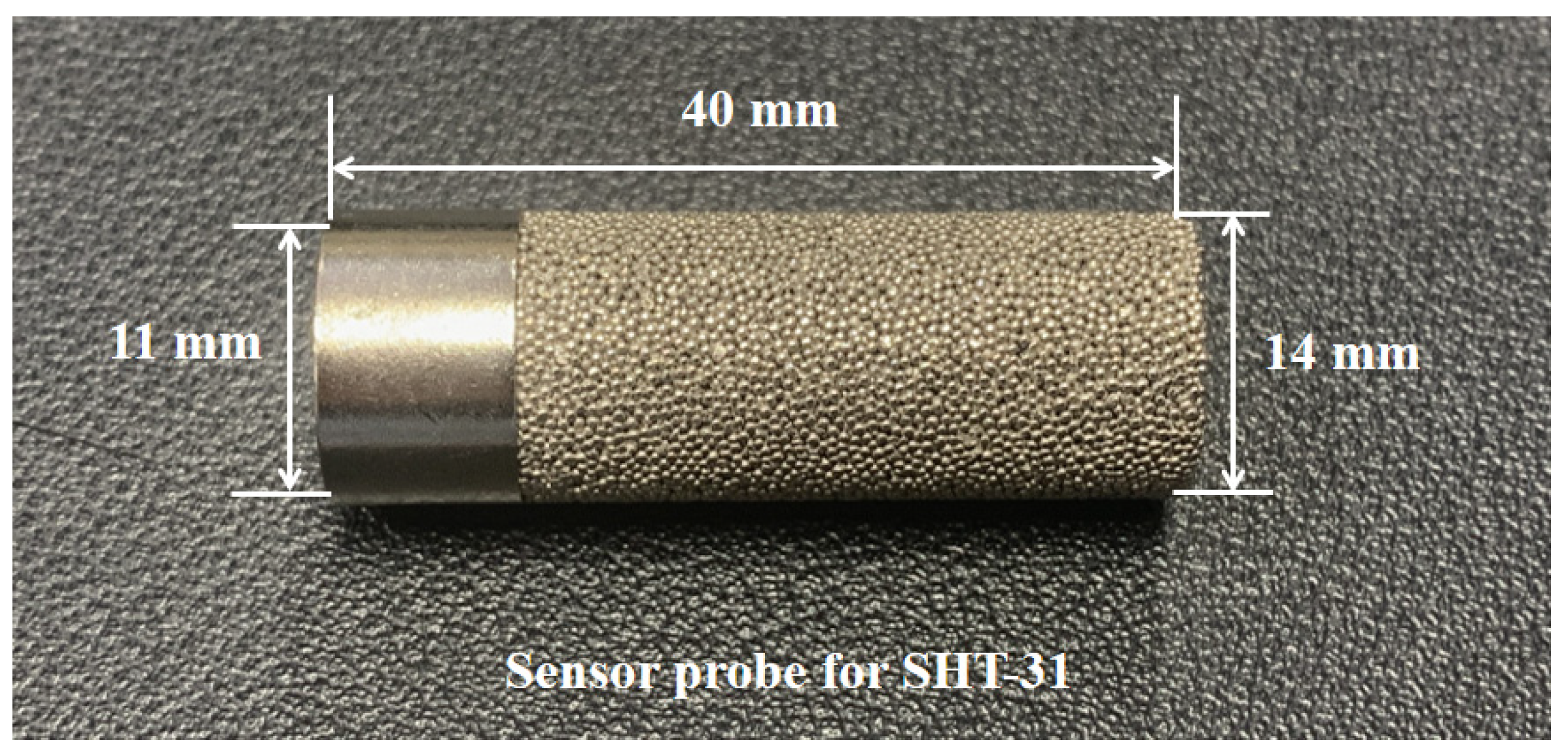
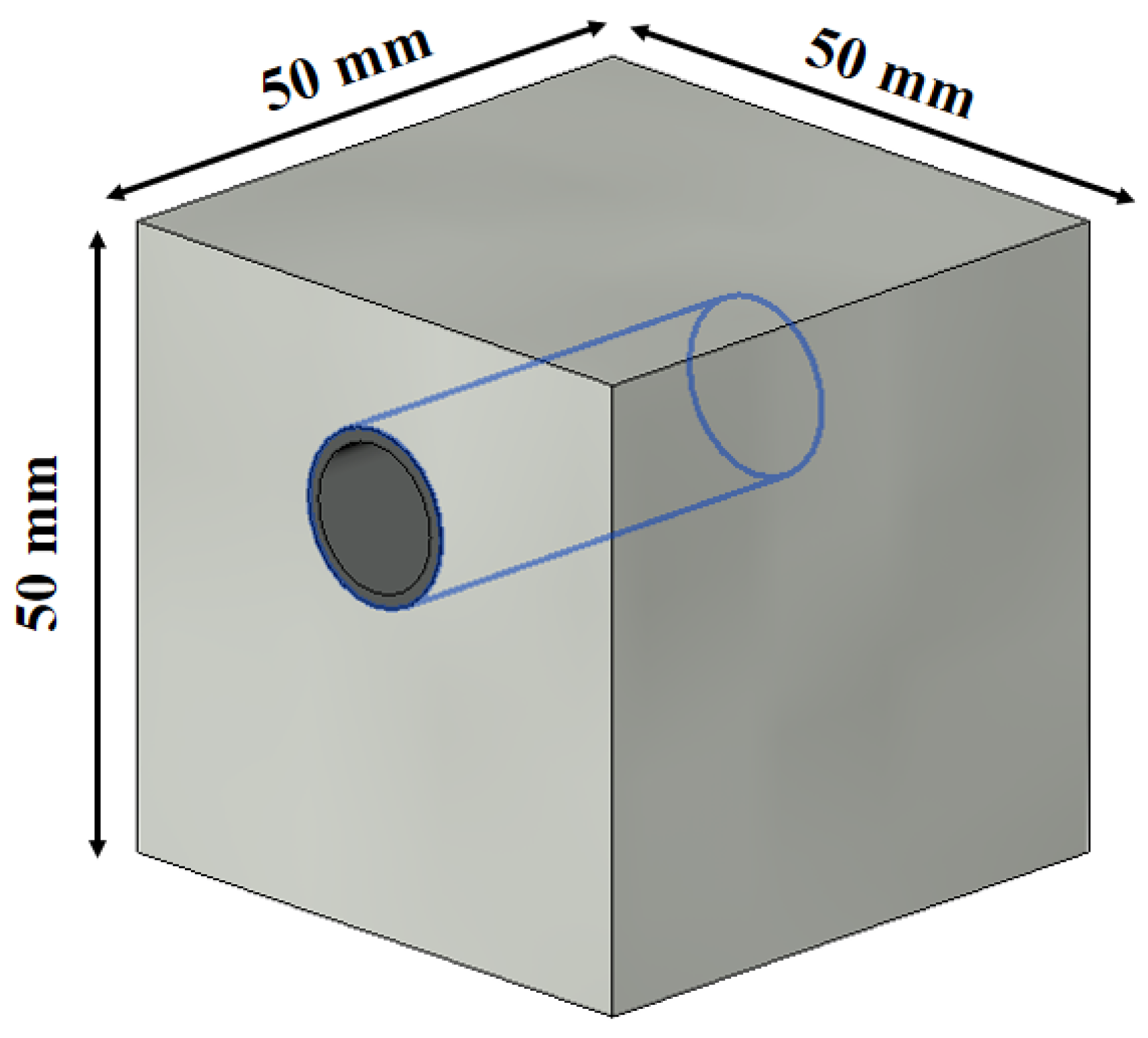
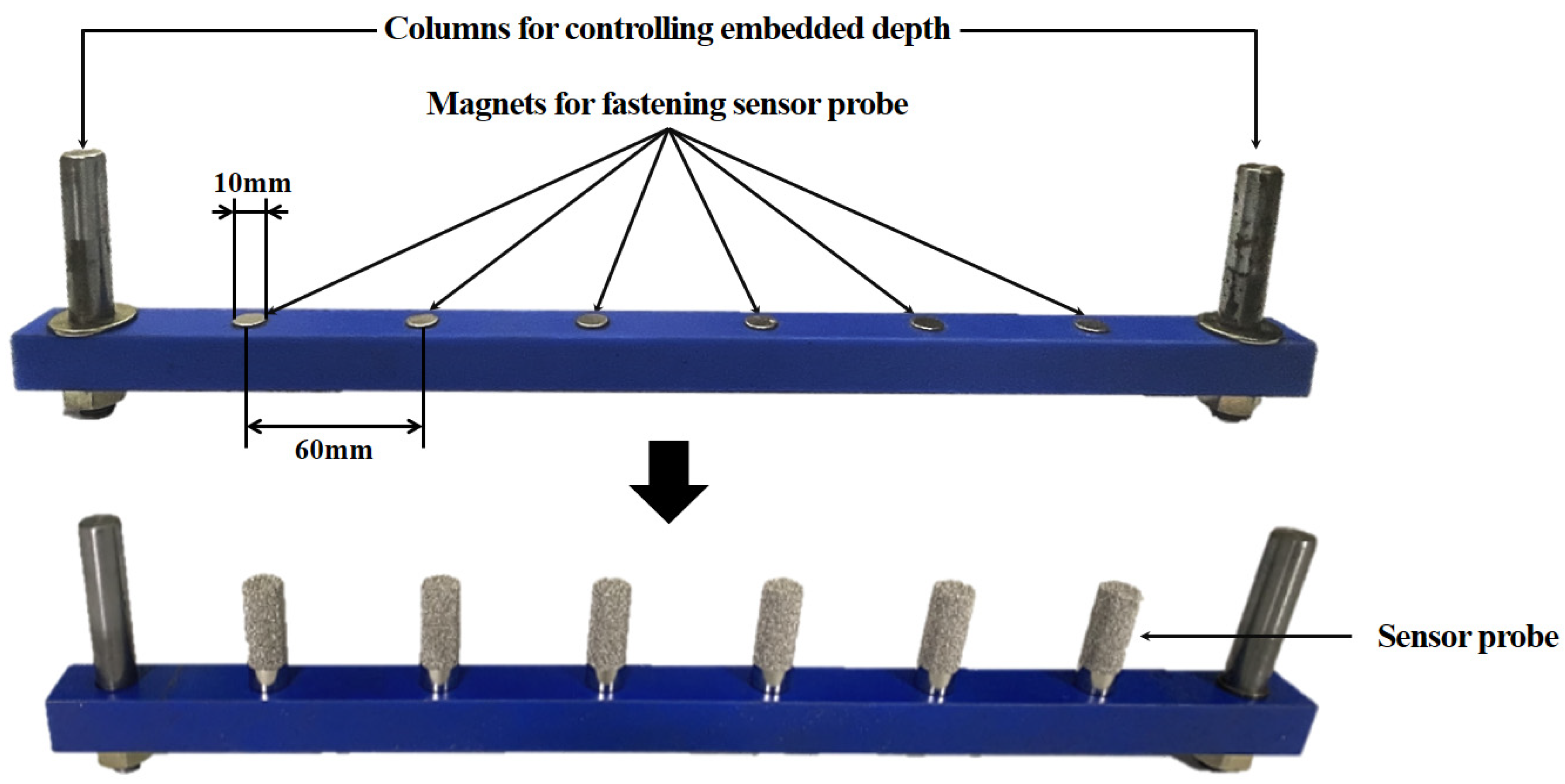


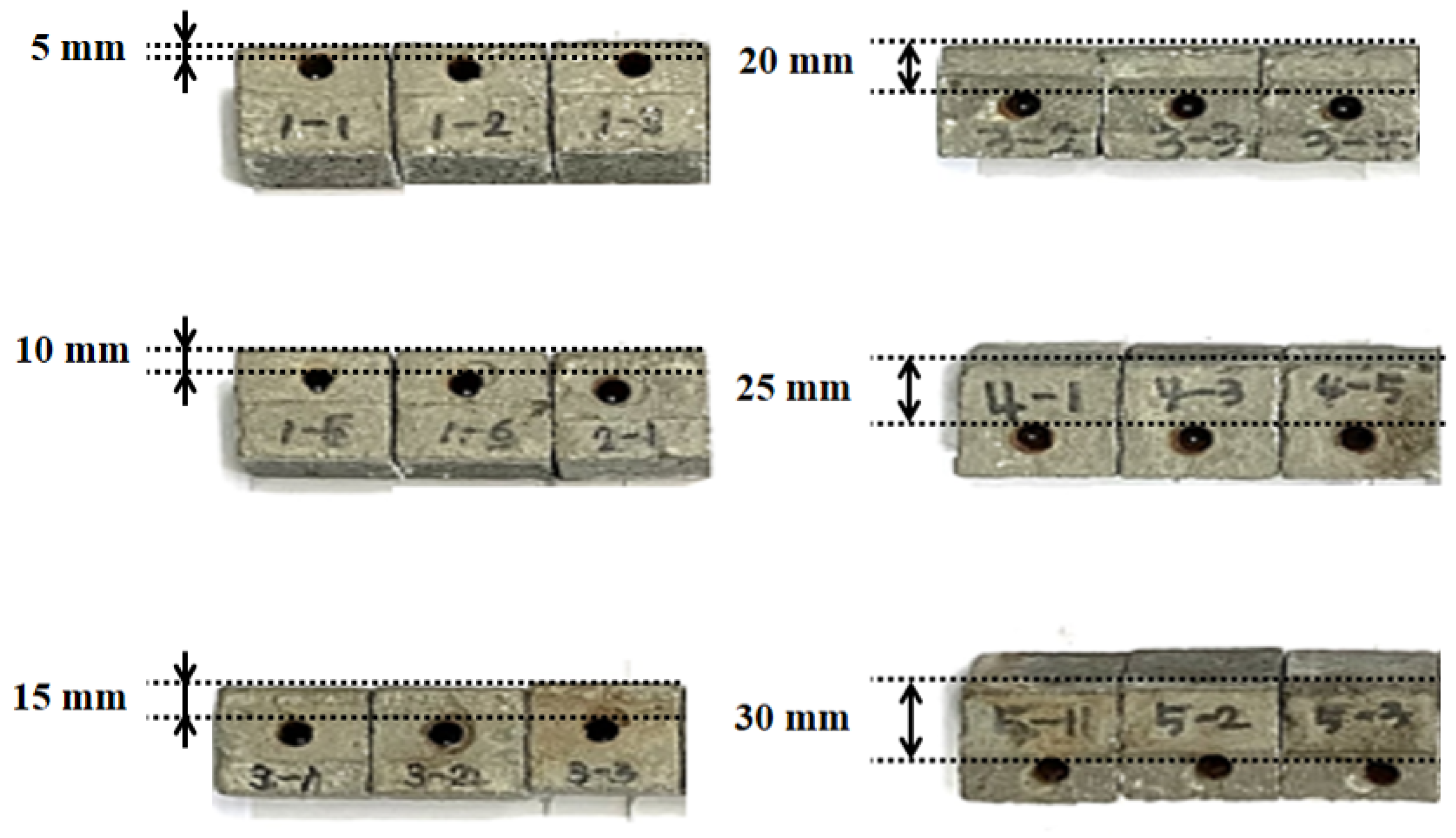
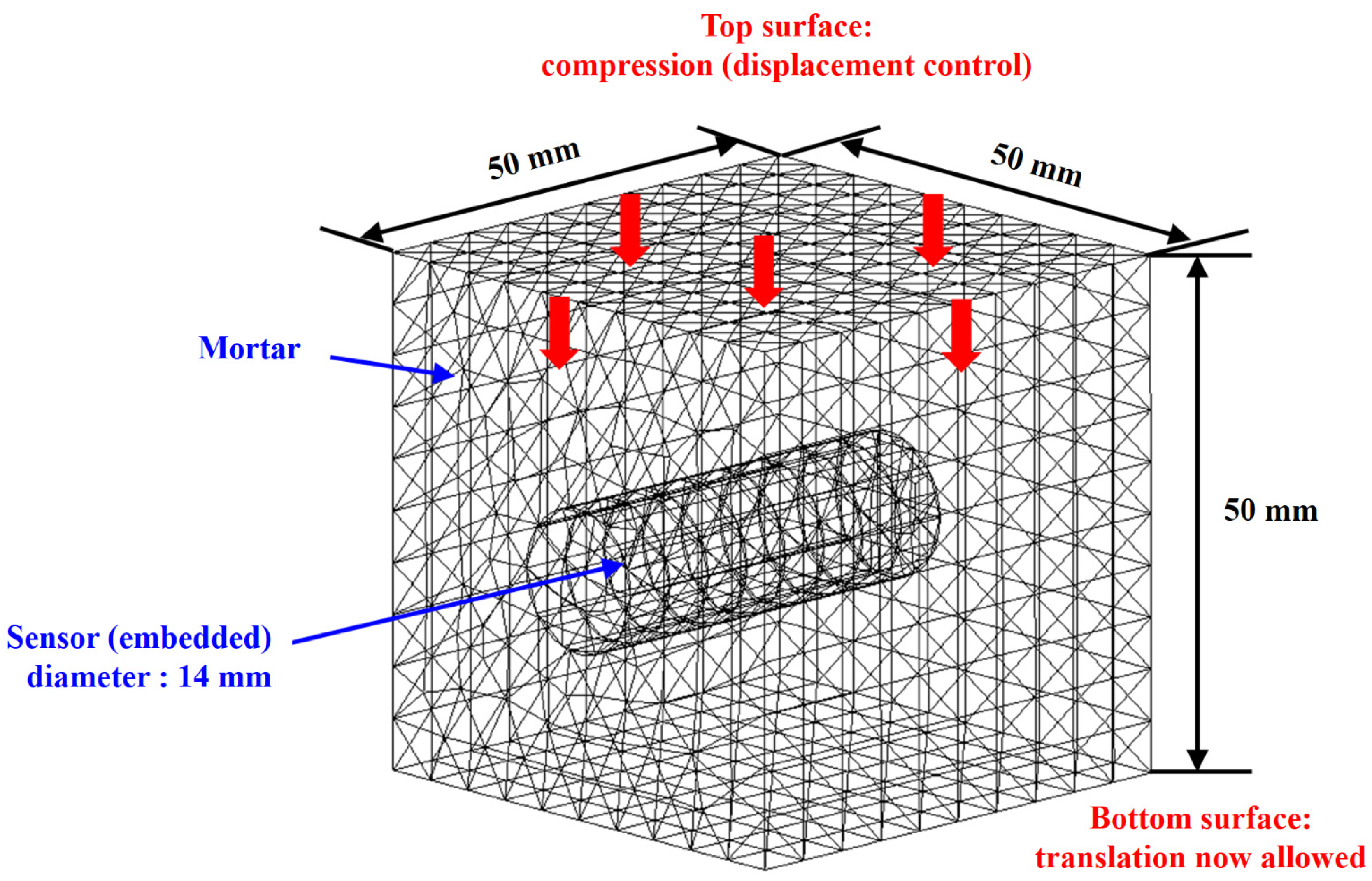
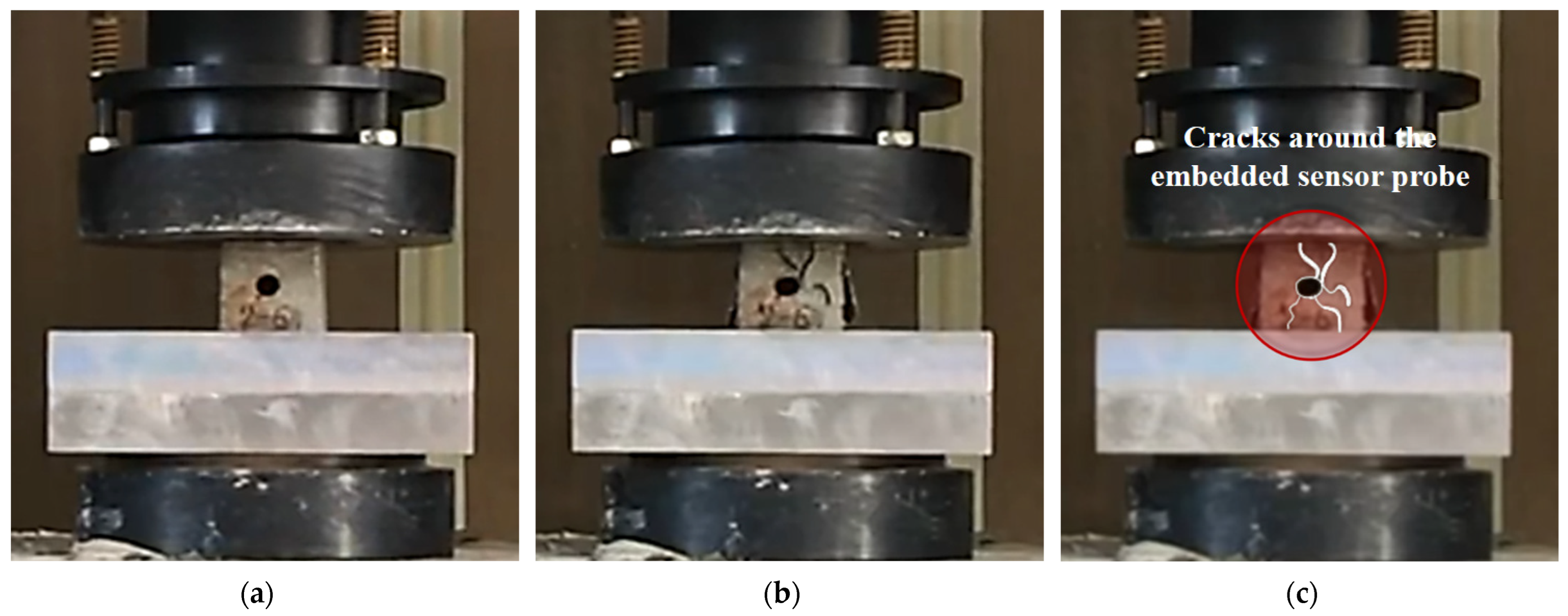


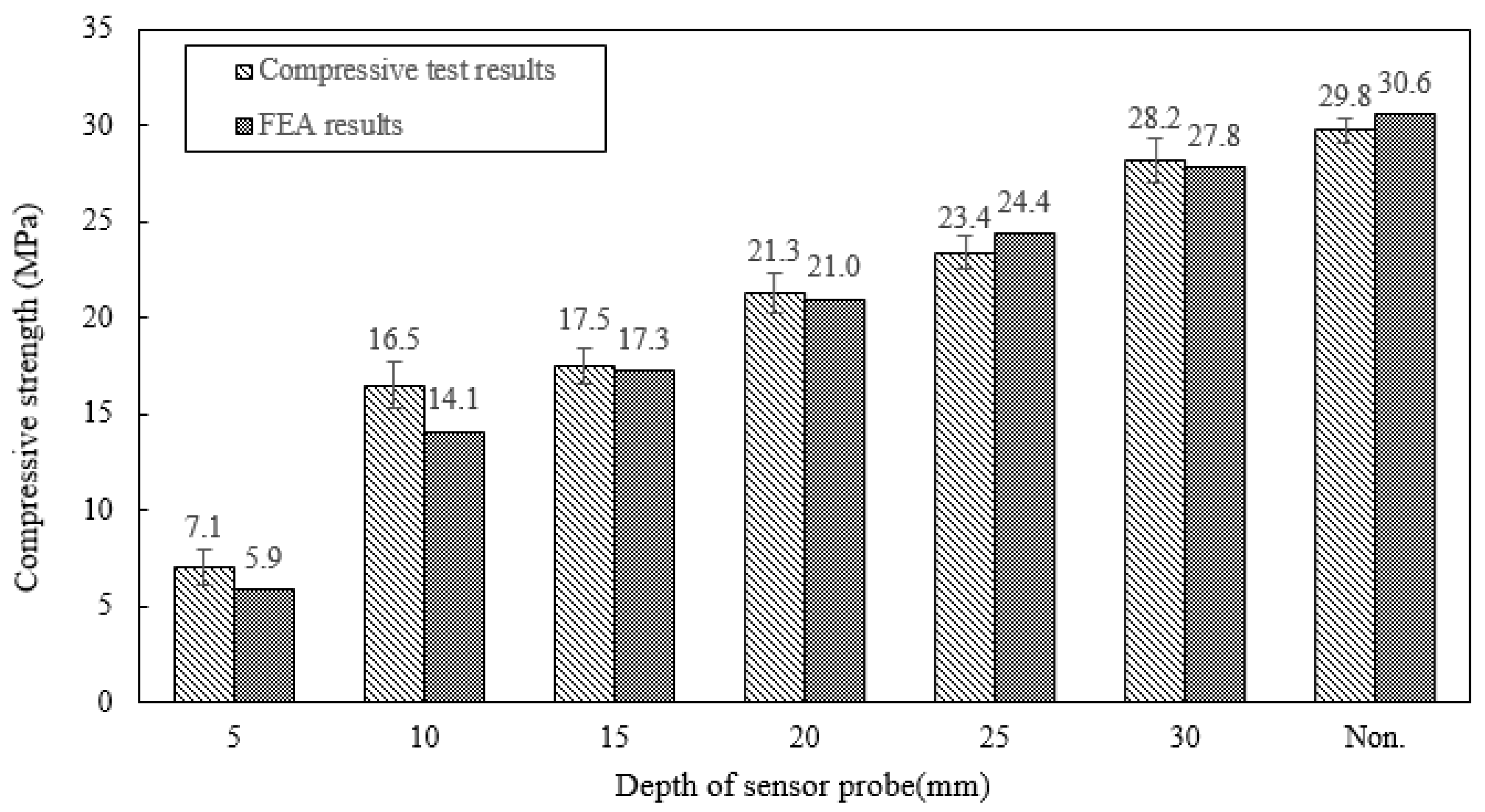
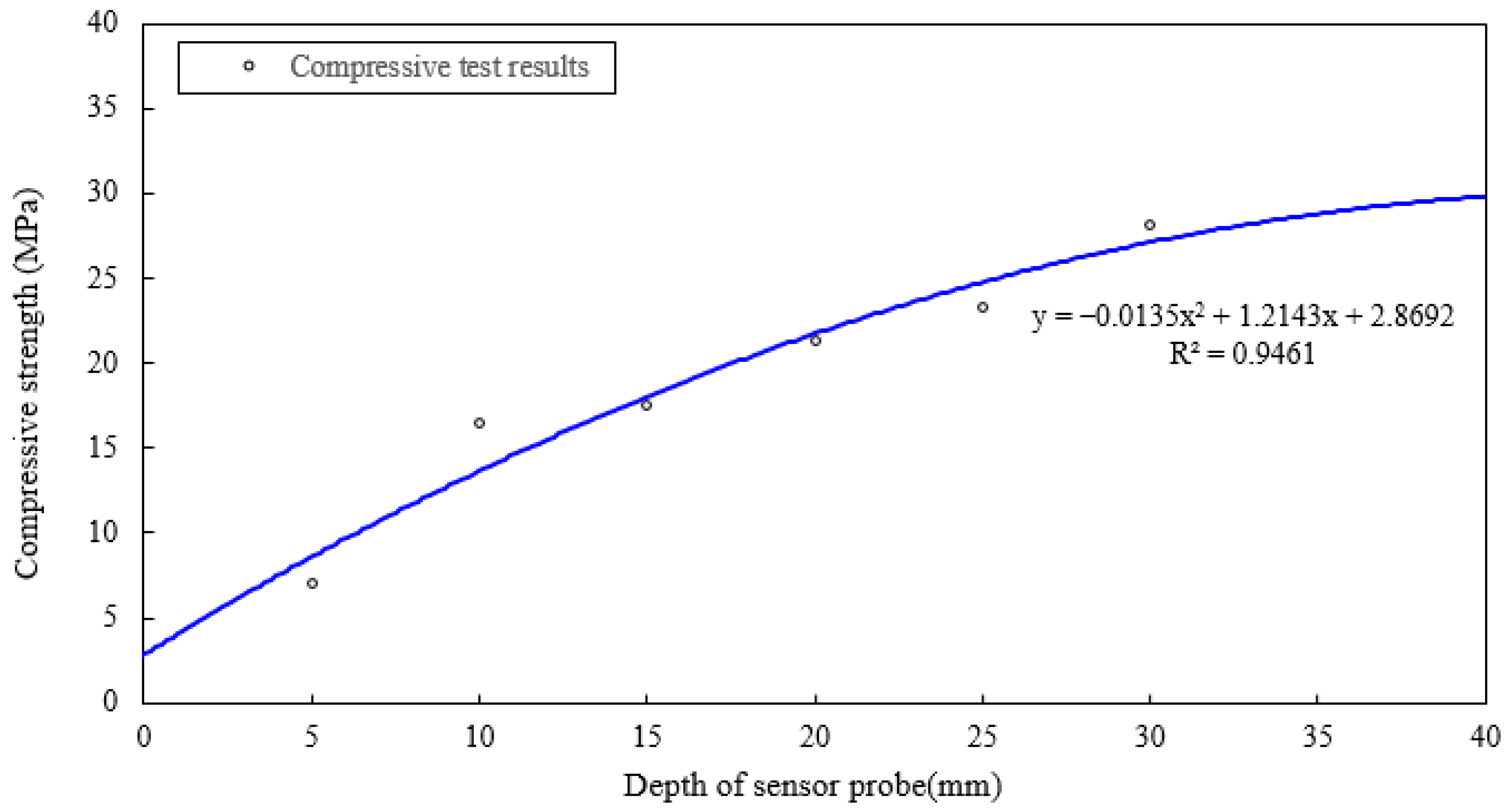
| Authors (Year) | Objective | Novelty |
|---|---|---|
| Ekaputri et al. (2016) [21] | Measuring relative humidity | Measuring the effect of BFS on the internal relative humidity of mortar |
| Zhou et al. (2016) [22] | Monitoring the propagation of cracks | Real-time monitoring of crack propagation using a cement-based piezoelectric ceramic sensor |
| Im et al. (2017) [23] | Monitoring the corrosion level of rebars within reinforced concrete | Measuring the level of corrosion by embedding the sensor |
| Pan and Huang (2020) [24] | Measuring mortar strength development | Monitoring the strength of mortar through PEC sensor and EMI technologies |
| Sampaio et al. (2022) [25] | Monitoring the pH concentration of steel embedded in mortar | Developing a sensor based on iridium oxide to detect the pH concentration of steel within mortar |
| Parameter | Ordinary Portland Cement (%) |
|---|---|
| SiO₂ | 22.5 |
| Fe₂O₃ | 3.6 |
| SO₃ | 2.3 |
| CaO | 62.9 |
| MgO | 2.1 |
| Al₂O₃ | 5.2 |
| Material Properties | Mortar | Sensor Probe |
|---|---|---|
| Elastic modulus (MPa) | 5000 | 140,000 |
| Poisson’s ratio () | 0.25 | 0.35 |
| Function coefficient (α) | 1.121 | - |
| Dilation angle (°) | 10 | - |
| Eccentricity of the plastic flow (ϵ) | 0.1 | - |
| Ratio of the tensile to the compressive meridian () | 0.667 | - |
| Viscosity parameter (μ) | 0.01 | - |
| Embedded Depth of the Probe (mm) | Compressive Strengths of Test Specimens (MPa) | |||
|---|---|---|---|---|
| Specimen #1 | Specimen #2 | Specimen #3 | Standard Deviation | |
| 5 | 8.380 | 6.544 | 6.344 | 0.92 |
| 10 | 16.166 | 15.244 | 18.180 | 1.23 |
| 15 | 16.460 | 18.768 | 17.360 | 0.95 |
| 20 | 20.028 | 22.612 | 21.276 | 1.06 |
| 25 | 22.184 | 24.180 | 23.748 | 0.86 |
| 30 | 28.296 | 26.744 | 29.472 | 1.12 |
| Non-embedded | 28.914 | 30.395 | 29.942 | 0.62 |
Disclaimer/Publisher’s Note: The statements, opinions and data contained in all publications are solely those of the individual author(s) and contributor(s) and not of MDPI and/or the editor(s). MDPI and/or the editor(s) disclaim responsibility for any injury to people or property resulting from any ideas, methods, instructions or products referred to in the content. |
© 2023 by the authors. Licensee MDPI, Basel, Switzerland. This article is an open access article distributed under the terms and conditions of the Creative Commons Attribution (CC BY) license (https://creativecommons.org/licenses/by/4.0/).
Share and Cite
Kim, C.; Song, Y.; Cho, J.; Kang, J.; Yeon, J. Effect of Embedded Depth of Copper-Nickel-Plated Sensor Probes on Compressive Strength Development of Mortar. Sustainability 2023, 15, 10772. https://doi.org/10.3390/su151410772
Kim C, Song Y, Cho J, Kang J, Yeon J. Effect of Embedded Depth of Copper-Nickel-Plated Sensor Probes on Compressive Strength Development of Mortar. Sustainability. 2023; 15(14):10772. https://doi.org/10.3390/su151410772
Chicago/Turabian StyleKim, Chaehyeon, Yooseob Song, Junhwi Cho, Julian Kang, and Jaeheum Yeon. 2023. "Effect of Embedded Depth of Copper-Nickel-Plated Sensor Probes on Compressive Strength Development of Mortar" Sustainability 15, no. 14: 10772. https://doi.org/10.3390/su151410772
APA StyleKim, C., Song, Y., Cho, J., Kang, J., & Yeon, J. (2023). Effect of Embedded Depth of Copper-Nickel-Plated Sensor Probes on Compressive Strength Development of Mortar. Sustainability, 15(14), 10772. https://doi.org/10.3390/su151410772








